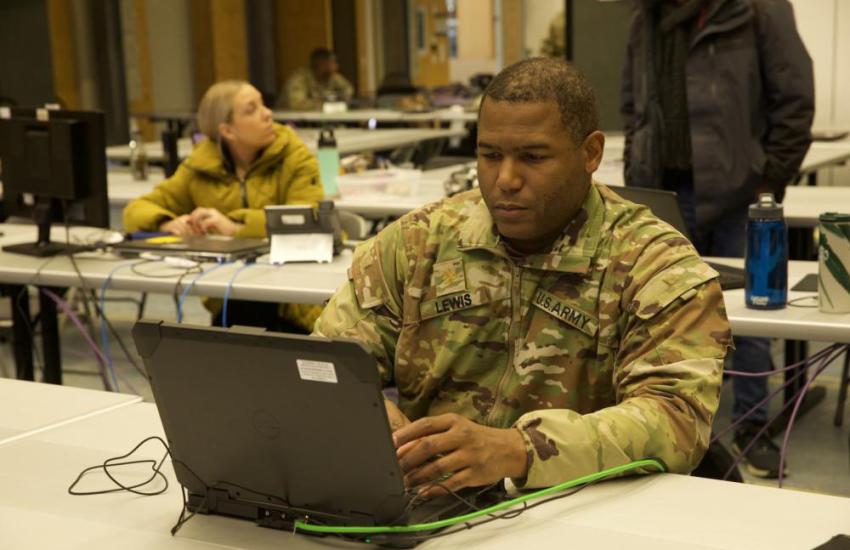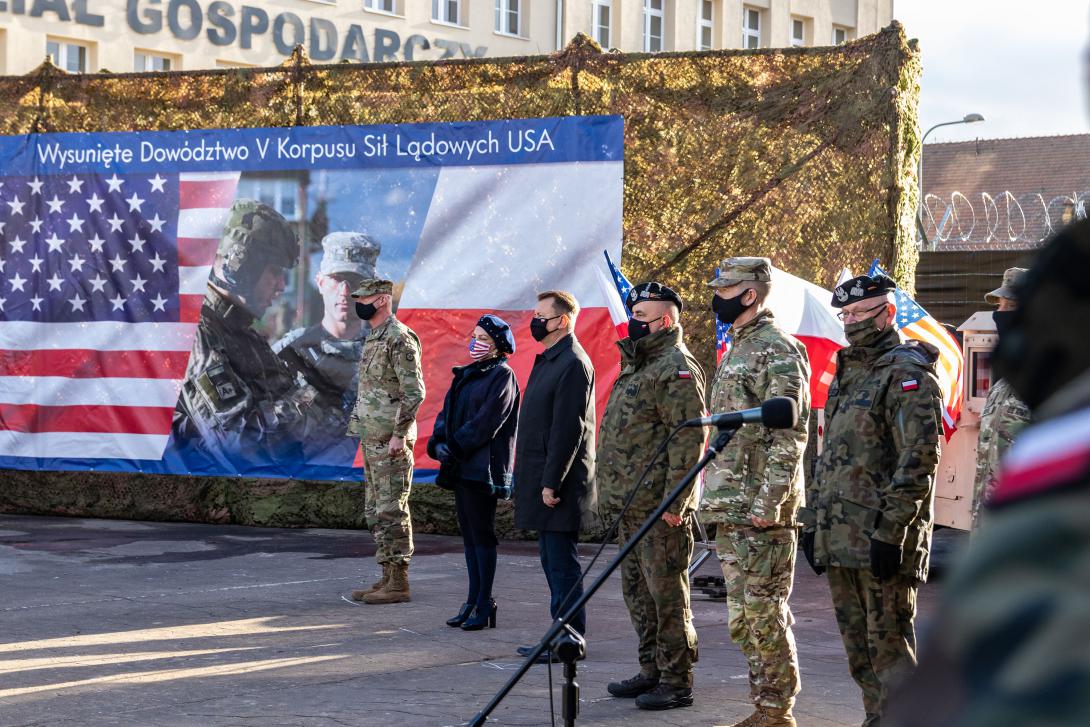V Corps Enhancing European Interoperability and Capabilities
It may seem counter-intuitive, but one of the most effective ways to deal with increasingly complex global challenges is for the U.S. Army to simplify its operations by expanding the interoperability of its weapons, mission command systems and communications.
Interoperability confers many benefits. Internal interoperability speeds up decision-making, reduces logistical strain and allows different Army units to communicate and operate in a coordinated fashion. External interoperability allows the Army to work closely with its sister services, as well as partners and allies, to counter challenges from China, Russia or other competitors. It allows the Army to act together coherently, effectively and efficiently to achieve tactical, operational and strategic objectives culminating in decision dominance for the United States, allies and partners against shared adversaries.
With that in mind, V Corps is proud to play an important part in implementing, testing and evaluating Army interoperability efforts. The unit has participated in multiple interoperability summits and Coalition Warrior Interoperability Exercises that are centered on finding engineering solutions to many of the technical interoperability issues that directly affect the NATO Response Force, Very High Readiness Joint Task Force and Federated Mission Networking (FMN). V Corps has also participated in the Defender Europe exercises with a future goal of being a multinational division operating under a U.S. corps.
Interoperability conferences and exercises have shown that persistent, constant efforts are needed to achieve success. These events have also taught that interoperability involves three different domains of activity: human, procedural and technical. Although several observations are specific to the V Corps mission, others are relevant to all Army units that work closely with joint and coalition partners.
In many ways, the toughest of these domains to master is the most obvious: human. This involves language, culture and interactions, or “liaison.” Coordinating disparate groups of individuals to work in concert is not easy, even when everyone speaks the same language and has the same heritage. Thus, it takes extra effort to build relationships, maintain awareness of different cultures and operate together with multinational allies and partners in Europe, Asia, Africa and South America.
V Corps has developed experience in achieving interoperability in multilingual and multicultural environments through continuous exercises with NATO allies. The team has found that building a high level of trust through frequent and persistent experimentation is imperative for improved interoperability.
Different procedures, which include doctrine, standard operating procedures and common institutions, can also inhibit interoperability. This can happen between sister services but is even more likely to occur when working with international partners.
A few examples include: How does your organization handle a call for fire? Who are your forward observers? On what frequencies do they communicate? Who evaluates the worth of the targets? Who decides whether to fire and which system will be used: aircraft, artillery or missiles? These may seem like mere details, but in the tumult common during actual combat, knowing who to talk to and when can determine how quickly and effectively you can make decisions and act.
Technical differences, such as network hardware, software and communication systems greatly increase the complexity of effective joint and combined operations.

Future U.S. Army mission success will depend highly on the ability, as a member of a combined element, to leverage technology to share information effectively and securely with unified action partners during operations. Currently, the vast majority of the technical interoperability implementation occurs at the U.S. Army Europe and Africa, U.S. European Command and NATO levels across the Mission Partner Environment (MPE) network.
MPE gives the Army, the joint forces and coalition mission partners access to an information environment that supports planning, training and the conduct of operations through all five joint operational phases with any mission partner at any time. It is a U.S. instantiation of the NATO Federated Mission Networking framework and is built to NATO standard to facilitate a zero-day network capability in the event of an Article V, under which an attack on one ally is considered an attack on all.
In the V Corps area of operations, U.S. Army Europe and Africa is the authorizing official for the MPE network, with 2nd Signal Brigade tasked to provide oversight for the entire theater network operations at their European Department of Defense Information Network operations center.
The United States and its allies currently operate on multiple classified networks, including Secret Internet Protocol Router Network, NATO Secret, Battlefield Information Collection and Exploitation System, Mission Secret, etc. MPE is the classified network that acts as the bridge for them all through data and voice services. As NATO and non-NATO members work toward becoming interoperable, MPE will serve as the trusted network built to the NATO Mission Secret standard for all nations working toward a common goal.
MPE generates strategic, operational and tactical flexibility for national, regional and deployed commanders by moving the fight from the Secret Internet Protocol Router Network and other U.S.-only networks onto a joint coalition FMN network with appropriate, common security features. Although it enables greater information sharing with allies, the technology also provides a hardened backbone that inhibits adversaries from gathering electronic intelligence from the network.
The FMN fosters mutual trust and confidence, enables shared understanding and is critical to achieving unity of effort across mission partners.
To maintain security when extending the MPE network, the best practice is to use fiber optical circuits, whether through a Global Agile Integrated Transport connection or a commercial circuit. Alternate means of transport connections should be a line-of-sight connection to a fiber point of presence, secure 4G LTE link or some other means of establishing a low-latency, high-bandwidth connection.
While a low-latency connection is the most optimal transport solution, extending network connections beyond MPE first involves establishing a link using satellite communications. Although satellite communications has bandwidth and latency limitations, it will typically be the first available connection because it can take several days to put secure fiber or other landlines into operation.
The demands on satellite communications utilization have led to bandwidth virtualization initiatives undertaken by the Landstuhl Regional Hub Node in partnership with 2nd Signal Brigade. They are educating regionally aligned forces on integration and commercial transport resiliency using emerging solutions such as high-throughput, low-latency, low-Earth-orbit systems.
The Army, its sister services, and partners and allies have conducted many exercises to test and establish interoperability.
The V Corps G6 routinely engages with European Command J6, U.S. Army Europe and Africa G6 and NATO Joint Forces Training Center seeking to enhance interoperability with NATO nations and mission partners.
Working closely with NATO partners using the NATO Secret Wide Area Network is one of the V Corps commanding general’s top priorities. This year, V Corps participated in Exercise Defender Europe 22, involving 28,000 multinational forces from 26 different nations, which focused on building operational readiness and interoperability between NATO allies and partners. These annual exercises are the largest Army-led, multinational, joint exercise designed to enhance and test operational readiness and interoperability with NATO allies and partners.
Thanks to these persistent engagements, V Corps has made significant progress in enabling interoperability with NATO partners beyond just core services and across all warfighting functions and domains. The command has prioritized core services provided by the network, such as reliable and resilient access to common core classified services, including voice (phone), email, chat and video teleconferencing through strategic and tactical connections. These core services are critical, but V Corps sees them as the baseline, not the end state, including Mission Command Information Systems, which provides the Army a common operational picture that displays combat power or capabilities from warfighting functions such as fires, intelligence and logistics.
To continue this progress into full network interoperability for all 30 NATO allies, V Corps has realized that the interoperability effort needs to embrace “persistence.” To achieve full interoperability, there is a need to move past temporary, episodic closed exercise networks. There also is a need to build a permanent system in which the connections and services are persistent and enduring and rooted in capabilities that will be organic to all the NATO member countries—not just U.S. Army Europe and Africa MPE. Building and running that system on a permanent basis will yield a treasure trove of information and help build a reservoir of trained personnel who will learn to address operating issues in network operations.
Paraphrasing former President Calvin Coolidge, “No training exercise can take the place of persistence” when it comes to building a reliable, interoperable communications and data network with the human, procedural and technical elements in place.
The end state has not yet been achieved, but there is movement in the right direction. Establishing a persistent demonstration program will eventually ensure true human, procedural and technical interoperability.
Col. Malcolm S. Bush, USA, assumed duties as the G6 for the recently activated V Corps Headquarters in August of 2022. He is responsible for synchronizing all planning, engineering, management, and systems integration of tactical and strategic networks operations both inside and outside the continental United States and across the range of military operations in support of U.S. national interests in the European theater.
Command Sgt. Maj. Jared Mitchell, USA, recently served as the V Corps G6 sergeant major and is now the 52d Signal Battalion command sergeant major.
The opinions expressed in this article are not to be construed as official or reflecting the views of AFCEA International.






Comments